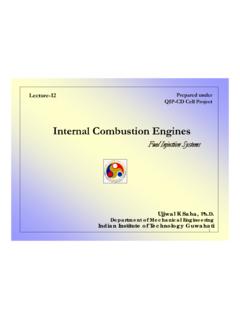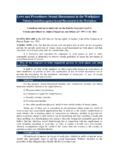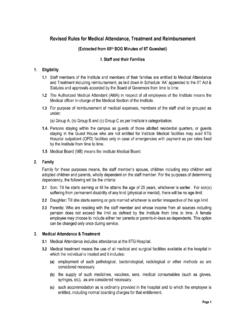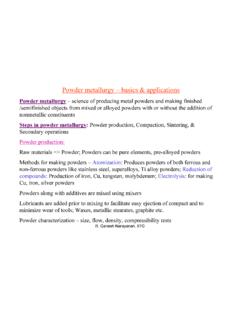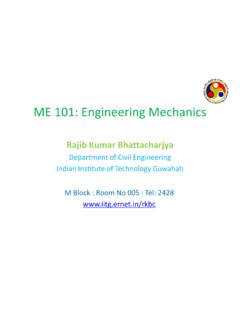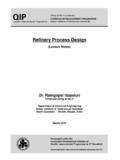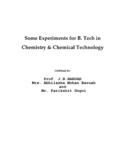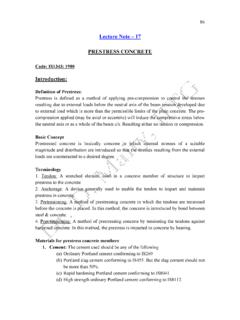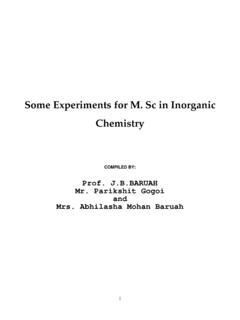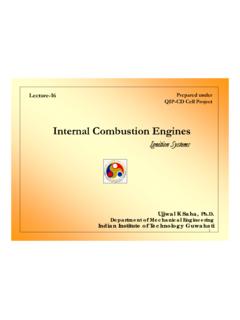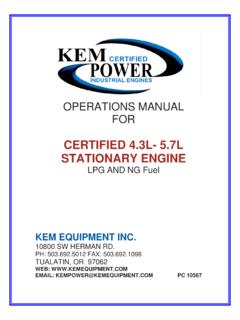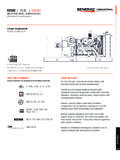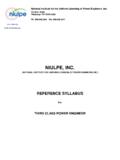Transcription of Internal Combustion Engines - iitg.ac.in
1 1 Internal Combustion EnginesLecture-5 UjjwalKSaha, of Mechanical EngineeringIndian Institute of Technology GuwahatiPrepared underQIP-CD Cell Thermal Energy Mech. WorkLossesEnergy in Fuel Heat Not wholly convertible to drive the pistonLoss to coolant, radiation and exhaust Remainder is converted to Power (to drive the piston), and this is the indicated Loss The brake power is always less than the indicated power because of frictional losses.(from piston to crankshaft via the connecting rod)Friction lossPumping lossfpipfpbp = Indicated power (ip), is the power actually developed in the cylinder. Brake power (bp), is the output power measured at the , ip = indicated power (kW)imep = indicated mean effective pressure (kN/m2)L = length of stroke (m)A = cross-sectional area of piston (m2)n = number of power strokes n=N/2 for four strokes, and n=N for two-strokesN = crankshaft speed (revolutions per minute)and K = number of cylindersIndicated power (ip) can be expressed as ()60 1000imepLAnKip=5 Brake power (bp) can be expressed as ()60 1000bmepLAnKbp=Brake power (bp) obtained at the output shaft can also be related as 260 1000 NTbp =where bp = brake power (kW)N = crankshaft speed (revolutions per minute)and T = engine torque (N-m)6 Specific Fuel Consumption.
2 It is defined as the fuel flow rate per unit power output, and can be expressed as Depending upon whether it is brake power or indicated power, the terms brake specific fuel consumption (bsfc), or indicated specific fuel consumption (isfc) is used. Accordingly, fmsfcP= &fmbsfcbp= fmisfcip= sfcis a measure of how efficiently the fuel supplied to the engine is used to produce power. Clearly, a low value of sfcis desirable since for a given power level less fuel is Specific Fuel Consumption vsEngine Size bsfcgenerally decreases with engine size due to reduced heat losses from gas to cylinder 2 = Note cylinder surface to volume ratio increases with bore Specific Fuel Consumption vsEngine Speed At high speeds the bsfcincreases due to increased friction losses.
3 There is a minimum in the bsfcversus engine speed curve As compression ratio is increased, fuel consumption decreases due to greater thermal efficiency At lower speeds, the bsfcincreases due to increased time for heat losses from the gas to the cylinder and piston wall, and thus a smaller ip9 Engine Efficiency Efficiency is the relation between the power delivered and the power that could be obtained if the engine operates without loss of power. Engine efficiency can be calculated two ways viz., Thermal efficiency and Mechanical Efficiency As time available for Combustion is very short, a small fraction of fuel does not react and exits with the exhaust flow.
4 A Combustion Efficiency is defined to account for the fraction of fuel burnt, and typically has values in the range of 95 % to 98 % when an engine is operating properly. inffcQmQ =where mf= mass of fuel= calorific value of fuelfQc = Combustion efficiencyinffcQmQ = 11 Thermal Efficiency: It is the ratio of power produced to the energy in the fuel burned to produce this power, and can be expressed as Depending upon whether it is brake power or indicated power, the terms brake thermal efficiency or indicated thermal efficiency is used. Accordingly, following two expressions can be = fuel mass flow rate= calorific value of fuelfPmthfQ = f;mbthfbpQ = fmithfipQ = fQfm 12 Mechanical efficiency: Mechanical efficiency usually lies between 80 to 90 %.
5 It can also be defined as the ratio of brake thermal efficiency to indicated thermal =It also follows thatbthmithisfcbsfc ==13 Air-Fuel Ratio: SI Engines may have A/F ratio in the range of 12 to 18 based on the operating conditions such as starting, accelerating, cruising etc. afmAFm=afmAFm= CI Engines , on the other hand, may have A/F ratio in the range of 18 to Correct or StoicheometricF/A: The mixture that contains optimum proportion of fuel air ratio. FAFAE quivalenceRatioActualRatioStoicheometric Ratio ==1;1;1;ChemicallyCorrectLeanMixtureRich Mixture = :1218:1870 AFAFSI enginesCIengines 15 Volumetric Efficiency:The power output of an engine depends directly on the amount of charge that can be inducted in the cylinder.
6 This is often referred to as the breathing capacity of the engine, and is expressed quantitatively as volumetric efficiency. It can be defined as the ratio of the volume of air induced to the swept volume of the cylinder, and can be expressed asavadmv =avadnmvN = where, ma= mass of air into the engine in one cycle (kg)= mass flow rate of air into the engine (kg/s) a= air density at atmospheric conditions (kg/ m3)Vd= displaced volume (m3)N = engine speed (revolutions per minute)and n = number of revolutions per cycleam 16 Volumetric Efficiency: Actual mass is always less than theoretical mass because of pressure losses in the ducting system and due to heat transfer (process is not adiabatic).
7 ArgargvActualmassofcheinductedTheoretica lmassofcheinducted =The volumetric efficiency for a normally aspirated engine is about 80 %, and this value can be increased by supercharging or turbocharging methods. 17 Improving Volumetric Efficiency: Modifying the intake passages that make it easier for the mixture to flow through as shown in Figure. Other changes include reshaping ports to smooth bends, reshaping the back of the valve heads, or polishing the inside of the Specific Weight Specific Volume EngineweightwEnginepowerbp==Indicates the relative economy with which materials are the relative effectiveness with which engine space is utilized. Specific Power ()pEnginepowerbpPistonfaceareaallpistons A==Measures the effectiveness with which piston area is used regardless of cylinder same power generation, air input in a 2-stroke engine is greater than a 4-stroke there is a loss in the scavenging period, the term volumetric efficiency (as applied to a 4-stroke engine) is replaced by the terms delivery ratioand charging Engines : 20 Two-stroke Engines : arg/dadciCylinderVolumeSweptVolumeVCylin derMassVmMassofFreshCheDeliveredIngested m =====()(.)
8 Re)argRe/argargtittcShortcircuitinginclu dingExhsidualsMassofFreshChetainedTrappe dmMassofCheLostmmMassofCheTrappedm == =Delivery Ratio: idrcmm =Charging Efficiency: tcecmm =drce Because some mixture is lost out of exhaust port before it is closed21 Two-stroke Engines : arg/dadciCylinderVolumeSweptVolumeVCylin derMassVmMassofFreshCheDeliveredIngested m =====()(.Re)argRe/argargtittcShortcircui tingincludingExhsidualsMassofFreshChetai nedTrappedmMassofCheLostmmMassofCheTrapp edm == =Trapping Efficiency: tteimm =Scavenging Efficiency: tsetcmm =Relative Charge: tccerccsemm ==22 Charging Efficiency = Delivery Ratio x Trapping Efficiency Charging Efficiency = Relative Charge x Scavenging Typical values23 Road-Load Power A part-load power level useful for testing car Engines is the power required to drive a vehicle on a level road at a steady speed.
9 The road-load power (Pr) is the engine power needed to overcome rolling resistance and the aerodynamic drag of the +=)21(2 24vvvDavRrSSACgMCP +=)21(2 where CR= coefficient of rolling resistance ( )Mv= mass of vehicleg = gravitational accelerationra= ambient air densityCD= drag coefficient (for cars: )Av= frontal area of the vehicleSv= vehicle speedRoad-Load Power Modern midsize aerodynamic cars only need 5-6 kW (7-8 HP) power to cruise at 90 km/hr, hence the attraction of hybrid cars!25 Specific volume, specific weight and specific power are the important parameters for Engines used in transportation vehicles such as boats, automobiles, airplanes, where keeping weight to a minimum is necessary.
10 For land-based stationary Engines , weight is insignificant. Modern automobile Engines usually have brake power per displacement in the range of 40 to 80 kW/L. Summary26 Summary The Honda eight-valve/cylinder V4 motorcycle engine generates about 130 kW/L, an extra example of a high-performance racing car engine. One main reason for continued development in two-stroke Engines is that they produce 40 % greater power output per unit weight. WH, Crouse WH, andandAnglin DLAnglin DL, (1985),Automotive Engines ,Tata McGraw TD, Eastop TD, andandMcConkey A,McConkey A,(1993),Applied Thermodynamics for Engg. Technologists, Addison CR, Fergusan CR, andandKirkpatrick ATKirkpatrick AT,,(2001), Internal Combustion Engines ,John Wiley & VGanesan V,,(2003), Internal Combustion Engines ,Tata McGraw PW, Smith JH, Gill PW, Smith JH, andandZiurys EJZiurys EJ,,(1959),Fundamentals of I.
